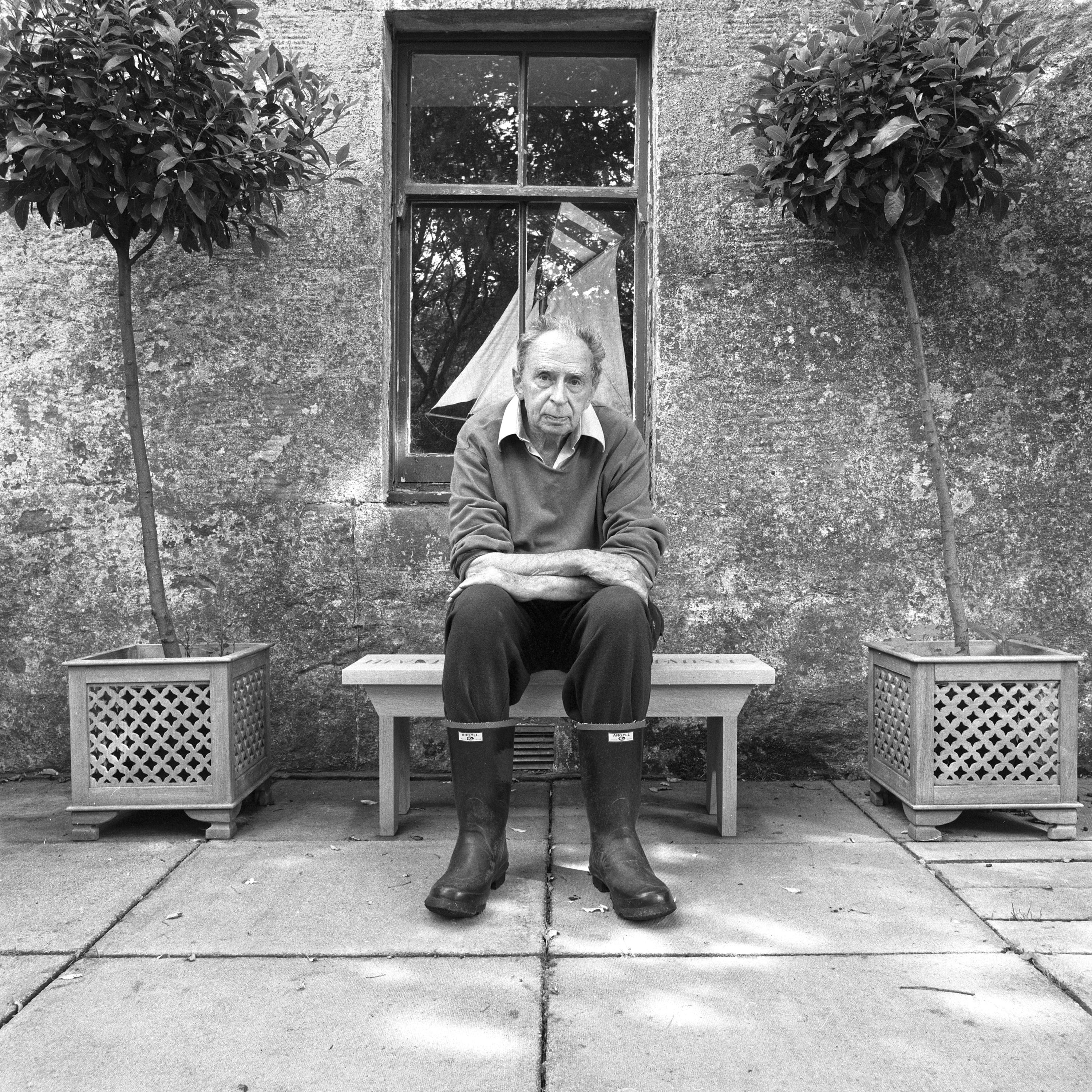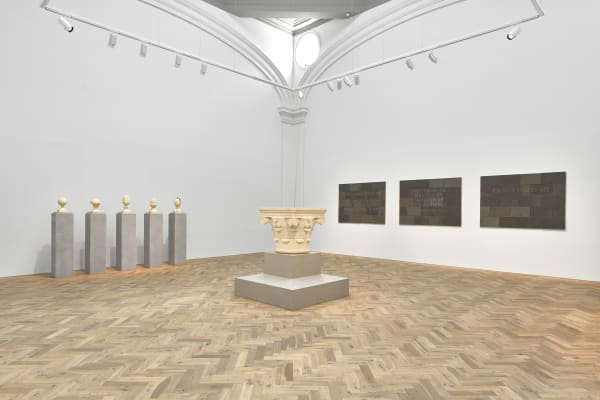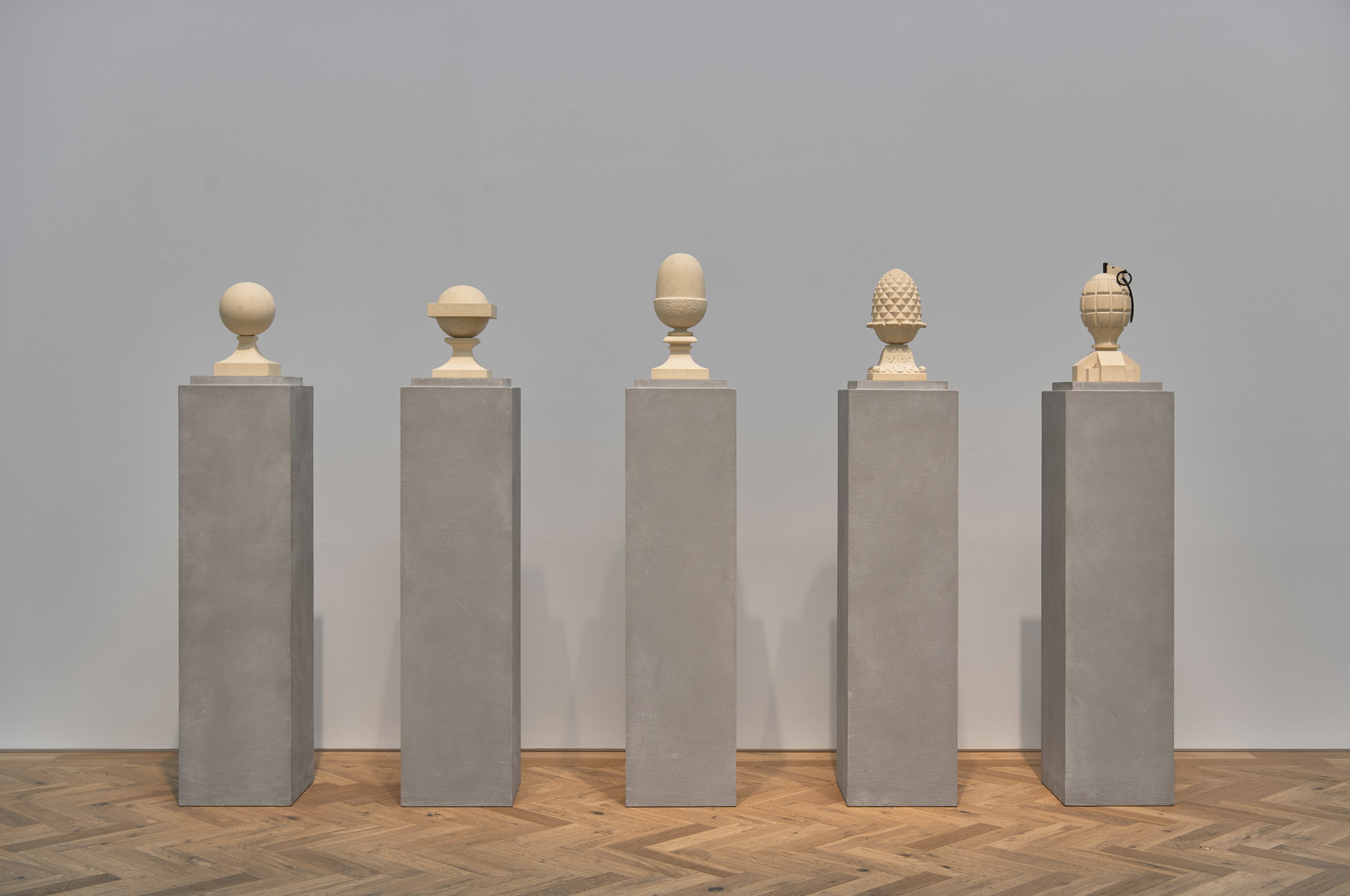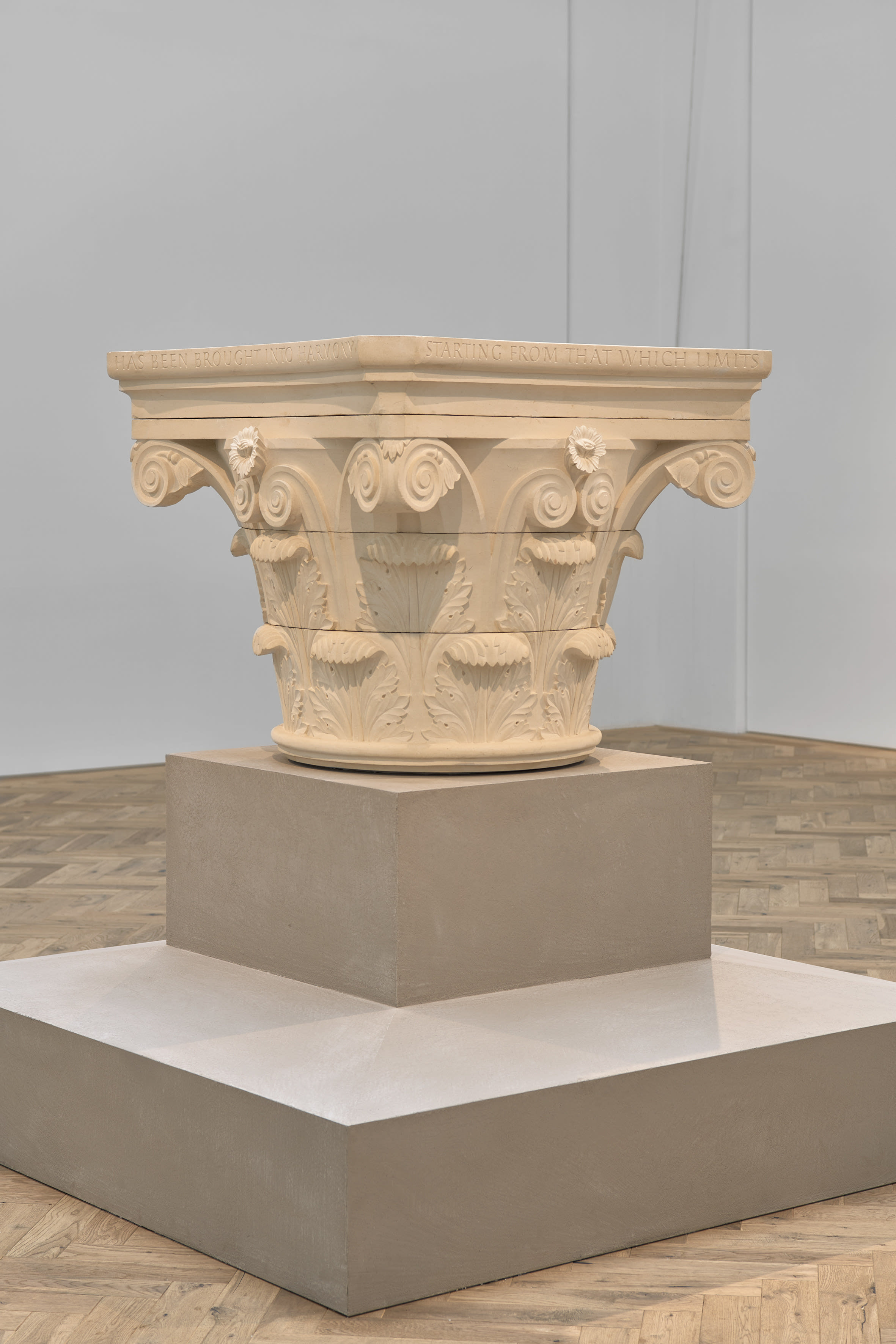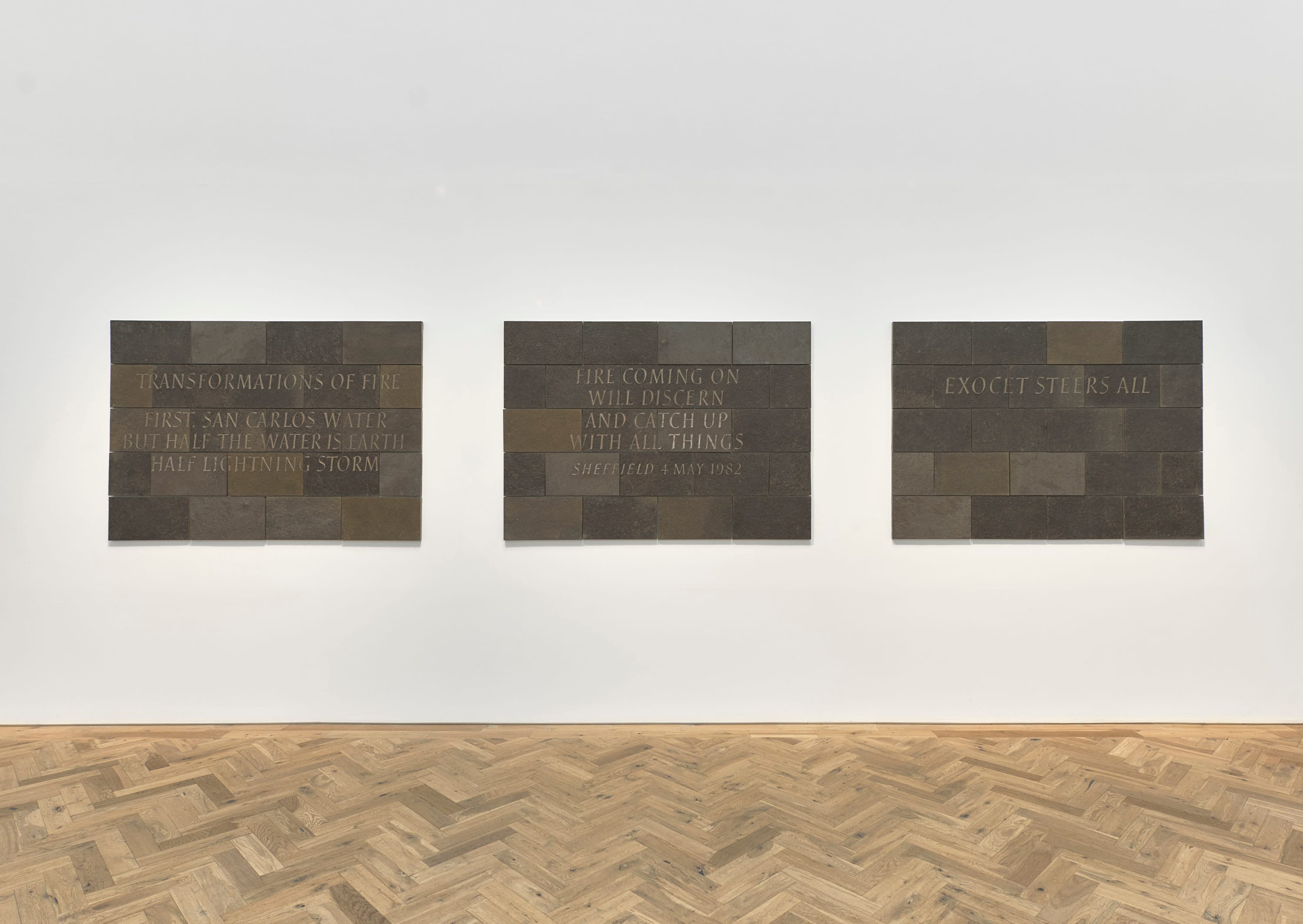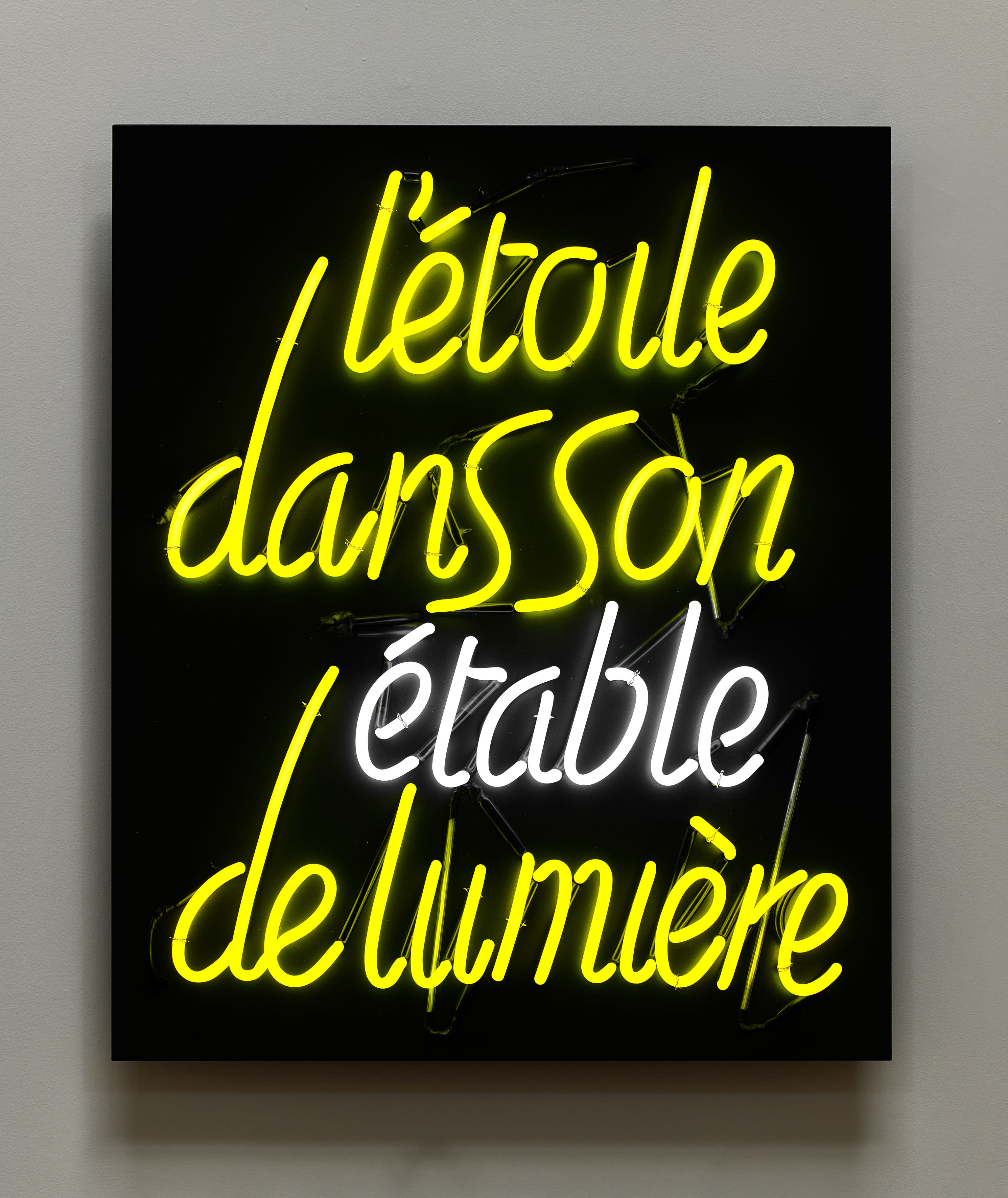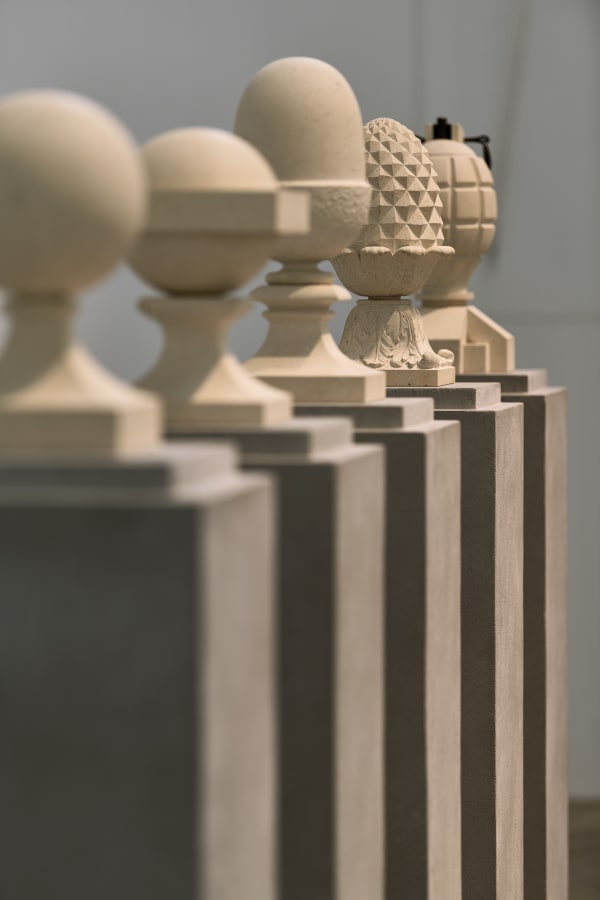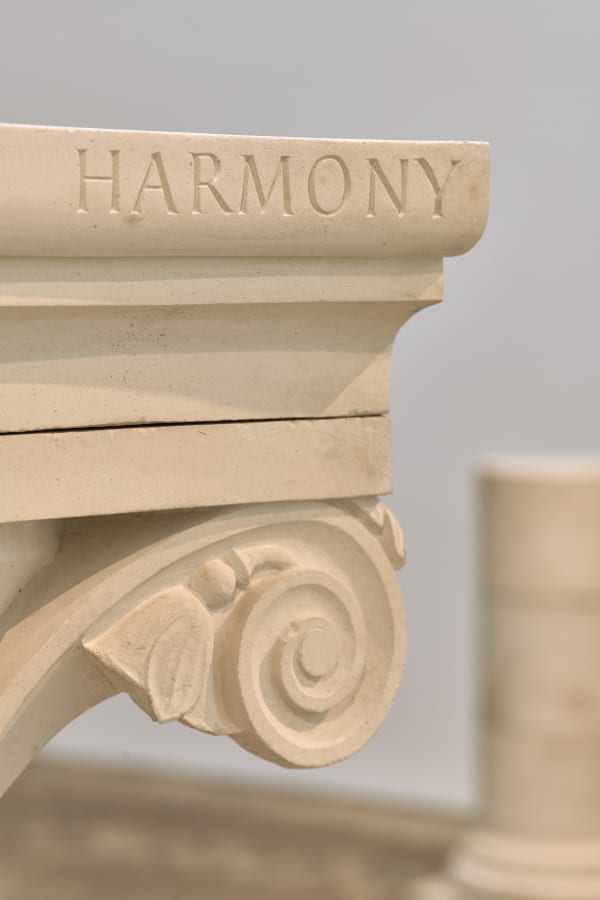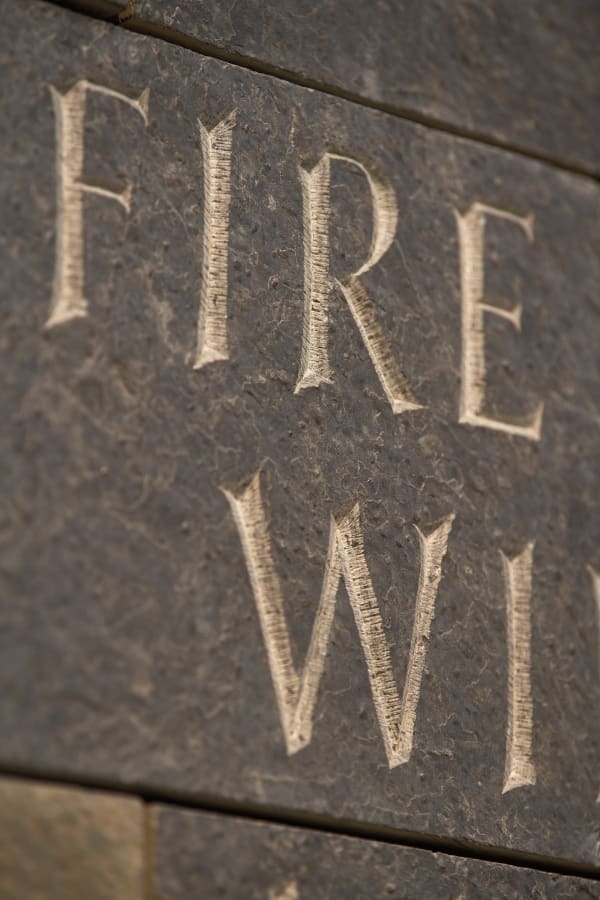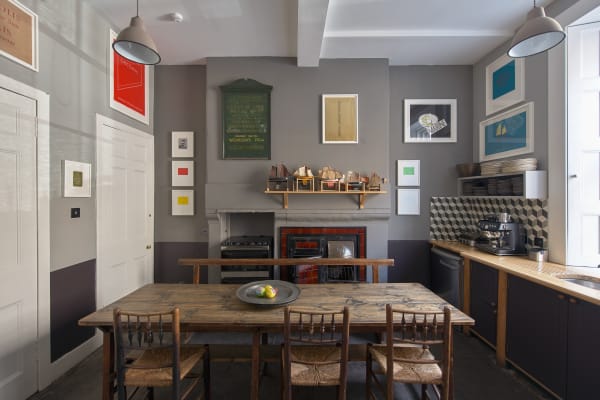-
This exhibition is one of eight opening concurrently under the title Fragments in London, New York, Brescia, Hamburg, Mallorca, Vienna, Basel and of course Edinburgh to celebrate the centenary of the late great Ian Hamilton Finlay. Poet, artist, and avant gardener. It explores a number of the key themes that recur in Finlay’s work including an interconnectedness of the Classical world, the French Revolution and 20th century warfare. The complexity of these related threads is underpinned by a consistently straightforward moral position. To borrow the words of Jean de Loist, writing specifically about Revolutionary works, in the Cartier Foundation catalogue Poursuites Revolutionnaires in 1987:
"For Finlay, the French Revolution is not a theme which illustrates, as one might ordinarily say of a painter and his subject. The Revolution is a metaphor of the artist's moral attitude to the world."
A fourth major theme, not explored in this exhibition, was man’s relationship with the sea - from Homeric exploration to the vernacular traditions of the Scottish fishing fleet. This theme is touched on in an ancillary display of archive prints from the 1960s onwards in the kitchen of the Glasite Meeting House. For further details of these works please contact the gallery.
-
 Portrait of Ian Hamilton Finlay © Norman McBeath RSA
Portrait of Ian Hamilton Finlay © Norman McBeath RSA -
Five Finials
Five Finials can be considered one of the greatest of Ian Hamilton Finlay’s later works. The idea behind the sculpture first appeared in the form of a folding card drawn by Andrew Townsend in 1992, with a subtitle provided by Ralph Waldo Emerson ‘Nature is upheld by antagonism’, before being carved in stone by Peter Coates in 1999. It presents a series of ornamental stone finials of the sort that might usually sit atop gateposts at the entrance to large house or country park. Usually placed in pairs, such finials offer a spirit of welcome and a touch of ornamental grandeur, but adapted here and presented in evolutionary sequence, they suggest (in a typically Finlay-esque manner) a poetic metaphor and a compendium of his ideas on art and architecture and the shifting parameters of society.
As the writer Prudence Carlson has noted: “These Five Finials, the first four of which are customary shapes, exhibit a progression from abstract to naturalistic, from less to more articulated: perfect sphere, Vanbrugh-ian ball (sliced by a square through its middle), simplified acorn, full bodied pinecone/pineapple and shockingly, grenade. The last stage of the metamorphosis, though wholly unexpected, is both formally and verbally consistent… we are now no so much invited to enter as to beware if we do.”
-
 Ian Hamilton FinlayFive Finials, 1999with Peter Coates
Ian Hamilton FinlayFive Finials, 1999with Peter Coates
Magnesian limestone and bronze in 5 partsdimensions variable
-
 Ian Hamilton Finlay, 'Five Finials', with Andrew Townsend, 1992, concertina, Wild Hawthorn Press, 14.7 x 10.4 cm (folded).
Ian Hamilton Finlay, 'Five Finials', with Andrew Townsend, 1992, concertina, Wild Hawthorn Press, 14.7 x 10.4 cm (folded). -
CAPITAL
‘The order of the world and all it contains results from that which is limiting and from that which is unlimited’
[Philolaus c.470 - 385 BC]
Words attributed to the pre-Socratic philosopher Philolaus are inscribed around the top of a Corinthian capital carved in stone. As the art historian and chronicler of Finlay’s work Stephen Bann has noted, “among the three types of capital that surmounted the columns of the Greek temples, the Corinthian was the closest to the natural world since it borrowed its design from the highly recognisable leaves of the herbaceous plant known as the Acanthus.” Bann recalls that in the Roman poet Ovid’s Metamorphoses, the nymph Acantha is transformed into a leaf by the god Apollo, but notes that in this work Finlay has gone to an earlier source for the inscription, the philosopher Philolaus of Croton. Philolaus was a follower of Pythagoras whose philosophy hinged on the idea that natural harmony belongs in a balance of those things that are ‘limited’ and those ‘unlimited’. From this he came to understand (two millennia ahead of Copernicus) that Earth is not at the centre of the universe. As Bann comments: “Luxuriant despite its strictly classical form, the capital, as we observe it, may be imagined to bridge this opposition.” Or to put it another way, there are those things that we can attempt to control, and those we must simply accept – a message that seems particularly apt for the present time.
-
 Ian Hamilton FinlayCapital, 1989with John Sellman and Michael Harvey
Ian Hamilton FinlayCapital, 1989with John Sellman and Michael Harvey
Lepine limestone in 4 parts100 x 100 x 100 cm
39 3/8 x 39 3/8 x 39 3/8 in -
SHEFFIELD: A FALKLAND MEMORIAL
HMS Sheffield was a type 42 Destroyer struck by an Exocet missile during the Falklands War in the South Atlantic on 4th May 1982, the first Royal Navy warship to be lost to enemy action since World War 2. For the 10th anniversary of the conflict Finlay conceived this inscription as a memorial to the twenty sailors who lost their lives, when the Sheffield was hit. The original plan was drawn up by his collaborator Andrew Townsend as an architectural design for a small memorial pavilion. The panels of riven Caithness stone were carved by Nicholas Sloane in 1992. One of Finlay’s favoured, and oft’ quoted, pre- Socratic sources was the philosopher Heraclitus who famously stated, ‘It is the thunderbolt that steers the course of all things’ suggesting, perhaps, that this powerful, often disruptive force, hurled by Zeus, controlled the flux and change of the cosmos. In this memorialising context it is used, in Finlay’s words: "to construct a fearsome parable… the destructive scenario of modern warfare is mapped onto Heraclitus’ elemental view of the cosmos: it is not now the ‘thunderbolt’ which ‘steers all’, but the technologically perfected missile.”
-
 Ian Hamilton FinlaySheffield: Falkland Memorial, 1992with Nicholas Sloan
Ian Hamilton FinlaySheffield: Falkland Memorial, 1992with Nicholas Sloan
riven Caithness stone in 3 parts127 x 185 x 2.2 cm
50 x 72 7/8 x 7/8 in -
THREE PEDESTALS (ROBESPIERRE, SAINT JUST, COUTHON)
A series of stylised and idealised portraits of three of the key figures in the history of the French Revolution. Augustin Robespierre, Louis Anton Saint-Just and Georges Couthon formed a powerful triumvirate within the Committee of Public Safety of the Legislative Assembly during the Reign of Terror in 1793 and 1794, until all three were arrested and executed during the month of Thermidor in the summer of 1794. As Finlay noted, this work can be seen as a successor, or even a postscript, to an earlier work Twelve Who Ruled which depicts all twelve of the Committee’s members as identical antique busts in which “The repetition of the same classical and ideal form implied that all individual characteristics had been suppressed. In their place the heroic ideals of the French Revolution were being celebrated – Plutarchian, inflexible and sublime.” Finlay continued, with specific reference to this work: “Instead of three heads to represent the three named members of the committee, the element of portraiture resides simply in the form of the pedestals themselves: Robespierre and Saint-Just being shown as severe and upright columns, while Couthon’s deformity (he suffered from a progressively crippling illness) is ‘classicised’ and idealised in the architectural mannerism of the ‘barley sugar’ twist. Contemporary minimalism is obviously a pre-condition for this work, no less than the classicism of the Revolution. Yet the striking absence of heads may remind us of the fact that these three revolutionaries all fell to the guillotine, victims of Thermidor.”
-
 Ian Hamilton FinlayThree Pedestals: Robespierre, Saint-Just, Couthon, 1987with Iain Stewart
Ian Hamilton FinlayThree Pedestals: Robespierre, Saint-Just, Couthon, 1987with Iain Stewart
Portland stone in three (3) parts101 x 45.8 x 45.8 cm (each)
39 3/4 x 18 x 18 in -
1794, A BEHEADING OF BOUQUETS
Continuing the theme of Revolutionary execution, the inscription on this work references the Spring of 1794 when the poet and politician Philippe Fabre d'Églantine was sent to the guillotine. The previous year the then in favour poet had the job of rewriting the new republican calendar, removing all religious and historical associations. The months were named to reflect the seasons and nature, celebrating plants, creatures and the rural economy. Fabre, who had added Eglantine to his name after spuriously claiming to have won an Eglantine rose in a literary competition, was guillotined on 5th April 1794, in the middle of the new month of Germinal – ironically the time of growth. Finlay’s laconic inscription plays with this irony and nods to d'Églantine’s assumed name, and the inevitable deadheading required by a diligent gardener in tending the roses.
-
 Ian Hamilton Finlay1794, A Beheading of Bouquets, 1987with Richard Grasby
Ian Hamilton Finlay1794, A Beheading of Bouquets, 1987with Richard Grasby
Portland stone30 x 81 x 11.5 cm
11 3/4 x 31 7/8 x 4 1/2 in -
L’ÉTOILE DANS SON ÉTABLE DE LUMIÈRE
'The Star in its Stable of Light'A work originally conceived as a two-sided Christmas card in 1964/5 and transformed into a neon artwork in 1976. It takes a few of the key elements of the instantly recognisable nativity scene and rearranges them to suggest a new image, the meaning of which is both festive and elusive, evoking both the shimmer of light around the guiding star, and the brilliant arrival of a new light in the world. More scientifically, in terms of a star itself, we are in the realms of what astro physicists call the ‘main-sequence’ of a star’s life where the balance of nuclear fusion and gravity creates the longest-lasting phase of its life cycle and therefore the star’s most ‘stable’ state.
-
 Ian Hamilton FinlayL'etoile dans l'etable, 1976neon mounted on metal76.5 x 64 x 5 cm
Ian Hamilton FinlayL'etoile dans l'etable, 1976neon mounted on metal76.5 x 64 x 5 cm
30 1/8 x 25 1/4 x 2 in -
 Ian Hamilton Finlay, ‘The Star in its Stable of Light’, 1964, card, 15.2 x 15.2 cm (folded).
Ian Hamilton Finlay, ‘The Star in its Stable of Light’, 1964, card, 15.2 x 15.2 cm (folded). -
-
 Installation view, Ian Hamilton Finlay | Fragments, 2025, Ingleby, Edinburgh. Photograph: John McKenzie.
Installation view, Ian Hamilton Finlay | Fragments, 2025, Ingleby, Edinburgh. Photograph: John McKenzie. -

Installation view, Ian Hamilton Finlay | Fragments, 2025, Ingleby, Edinburgh. Photograph: John McKenzie.
-

Installation view, Ian Hamilton Finlay | Fragments, 2025, Ingleby, Edinburgh. Photograph: John McKenzie.
-

Installation view, Ian Hamilton Finlay | Fragments, 2025, Ingleby, Edinburgh. Photograph: John McKenzie.
-
-
IAN HAMILTON FINLAY was born in Nassau, Bahamas in 1925, a fact which he would later describe as ‘ridiculous, not in character at all’. His father was a bootlegger, smuggling rum to the USA during prohibition, and the young Finlay was sent back home to Scotland, aged six, to Larchfield, a boarding school in Helensburgh where the 24 year old poet WH Auden had recently joined the staff. Larchfield was followed by Dollar Academy and following a brief stint at Glasgow School of Art he found work as a shepherd and labourer in Perthshire and Orkney. Finlay started to write plays and poems in the 1950s and by the mid 1960s had emerged as one of the leaders of the concrete poetry movement. Over the next 40 years became he one of Scotland's most distinguished artists: a poet, philosopher and gardener whose work was frequently exhibited in the great museums of the world, despite Finlay himself rarely leaving the home in the Pentland Hills where he lived from 1966 until his death in 2006.
He is probably best known for Little Sparta, the classical garden he built in close collaboration with his wife Sue in the midst of a bleak Scottish moor. Ian the poet, Sue the gardener tending the poems as he described it. Little Sparta is often, and deservedly, referred to as Scotland’s greatest C20th work of art and represents a fusion of so many of Finlay’s artistic ideas, and principally his concern with man's relationship to nature. With the assistance of his many collaborators, Finlay translated his proposals into myriad different materials. From sculptures in stone and glass and neon, to postcards, prints and booklets, they are united in diversity by their place in Finlay's fundamentally poetic view of the world.
Little Sparta will open for the 2025 season on 1st June 2025 www.littlesparta.org.uk
-

Ingleby | Ian Hamilton Finlay | Fragments
Past viewing_room
